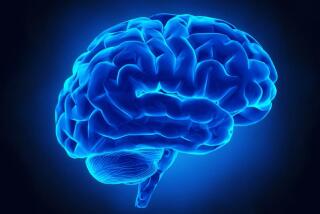Alzheimer’s Research Targets Indiana Family With History of the Disease
- Share via
INDIANAPOLIS — An exhilarated Dr. Martin Farlow collected spinal fluid samples last spring from members of an Indiana family plagued by a history of Alzheimer’s disease.
He and other researchers at Indiana University and a California company are working on a test to detect the disease that robs people of brain power, and eventually kills them.
If their hypothesis holds up, it may lead to the first tool to identify Alzheimer’s victims before they show clinical symptoms. That could eventually lead to early treatment, or at least allow victims to plan for the inevitable onset of dementia and death.
The discovery also may provide direction for researchers worldwide trying to learn more about the mysterious ailment.
Their findings are preliminary, Farlow and a colleague caution.
“You’re starting to get at the mechanism that causes the disease,” Farlow, a clinical neurologist, said in an interview at IU Medical Center in Indianapolis. “Where it will all lead, no one knows. One hopes it will lead to good places.”
Dr. Robert Katzman, an Alzheimer’s expert at UC San Diego, said other researchers have tried similar approaches, only to have their tests prove lacking.
“If it did hold up, and (it identified) individuals on the way to getting Alzheimer’s, that could provide a very potent tool to investigators,” Katzman said.
Farlow and colleagues at the university and at Salk Institute Biotechnology-Industrial Associates in La Jolla, Calif., published an article in August in the British journal The Lancet documenting how a genetic test showed the onset of Alzheimer’s in a 39-year Indiana resident who had not shown outward signs of the disease.
The patient’s family has a history of inherited Alzheimer’s that researchers have studied since the 1960s. Those who developed the disease generally showed clinical symptoms by their early 40s and have died within seven years. The family has demanded anonymity and has declined to be interviewed.
Alzheimer’s is the leading cause of human dementia and the fourth-leading cause of death among older people. Some cases are inherited; most appear to be sporadic. University of Washington researchers have reported findings showing there could be several biological pathways leading to Alzheimer’s.
Diagnosis usually is made by ruling out other diseases, and can be confirmed only by examining the brain.
Farlow, genetics expert Dr. Merrill Benson and other researchers in Indianapolis last October published a paper explaining how they had found a mutation in the same gene on chromosome 21 in three successive generations of the Indiana family. The gene where the mutation occurred affected production of amyloid beta protein, which forms brain deposits called plaques that are a hallmark of Alzheimer’s.
Steven Wagner, a biochemist at Salk, read the research and contacted Farlow about a spinal fluid test he was developing that measured the level of amyloid precursor protein, the larger compound from which amyloid beta protein is formed.
“What was the most fantastic thing they did was being able to go back three generations and be able to prove this point mutation,” Wagner said.
Wagner’s test was performed on a living member of the Indiana family with the mutation and already showing signs of severe Alzheimer’s. It showed a low level of APP, confirming Wagner’s hypothesis.
“Almost literally the next day, I obtained samples from as many people as I could,” Farlow said. He sent samples from six family members ages 31 to 45 to Wagner, whose blind testing on three with the genetic mutation revealed:
* An abnormally low level of APP in the 44-year-old person already showing symptoms. The level was similar to those taken from persons who had died of Alzheimer’s.
* A low level in a 39-year-old family member who appeared symptom-free but in whom additional testing actually showed impairment of memory and thought processes.
* Normal levels in a symptom-free 35-year-old family member.
Wagner said he does not believe the test will ever be able to predict which members of a family will develop hereditary Alzheimer’s, but may diagnose them in the early stages of the disease.
“Marty and I are both very excited about these results, but we won’t know for sure until we run much larger numbers of samples (and find) how useful the test is in a clinical setting,” Wagner said in a telephone interview.
Additional research and regulatory review would take at least a few years.
Under the researchers’ theory, if the test eventually proves valid, it would apply to all forms of Alzheimer’s because the low levels of APP would be common among sufferers of the disease.






